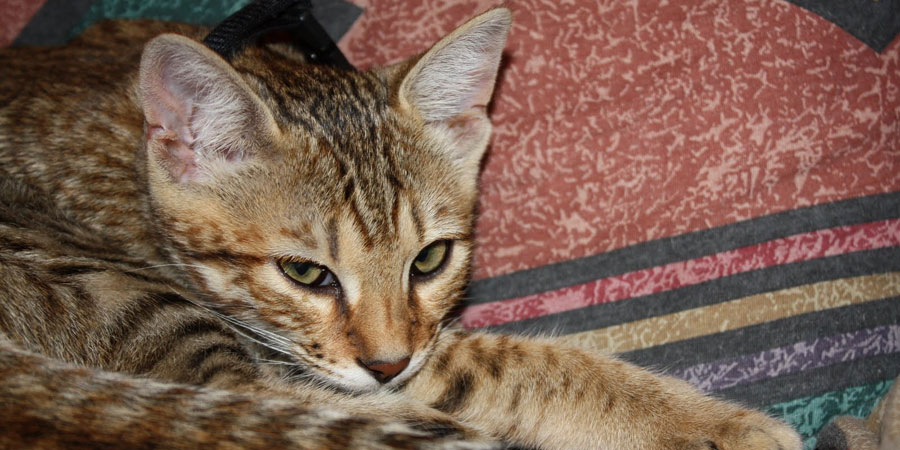

Overview
The Bengal is a domestic cat breed developed to look like exotic jungle cats such as leopards, ocelots, margays and clouded leopards. Bengal cats were developed by the selective breeding of domestic cats crossed then backcrossed and backcrossed once more with hybrids from the Asian leopard cat (ALC), Prionailurus bengalensis bengalensis, and domestic cat, with the goal of creating a confident, healthy, and friendly cat with a highly contrasted and vividly marked coat. Bengal cats are typically larger than the average house cat. Males on average weigh between 10-15 lbs (4.5 – 6.8 kg) and females 8–12 lbs (3.6 – 5.4 kg). The International Cat Association recognizes several Bengal colours (brown, seal lynx point, mink, sepia, silver) and patterns (spotted and marbled) for competition and shows. In the New Traits class, other colours may be shown, as well as longhairs.
Its fierce appearance is a complete contrast to its docile, gentle and sociable behavior. These intelligent, curious cats have a striking resemblance to dogs in terms of their traits. The Cheetoh is an excellent lap cat, loving to be in the company of human beings throughout the day. Being trustworthy, sociable, amicable and affectionate, they are well suited for children, dogs, and other cats. The male cats are not at all hostile, displaying maternal affection towards the kittens as well as the juvenile cats. They have inherited this trait from the Ocicat. They are so fond of playing that they even go to the extent of waking up their owners in the morning to get started. These attention-seeking cats do not like to be on their own so give them company always or bring in another pet in your household to keep it entertained.
| Size | Medium to Large |
| Height | |
| Weight | Male: 10 - 15 poundsFemale: 8 - 12 pounds |
| Lifespan | 12-14 years |
| Colors | Brown Seal lynx point Mink Sepia Silver |
| Origin | United States |
| Classification | |
| Good Lapcat | No |
| Good In Apartments |
|
| Good With Children |
Good With Others: It is usually good with everyone and can be very affectionate towards them. |
| Good With Dogs |
|
| Good With Cats |
|
| Exercise Needs |
|
| Trainability |
|
| Affectionate |
|
| Playfulness |
|
| Grooming Requirements |
Low Maintenance: Occasional grooming is advised to keep its coat in good shape. Though we see cats regularly lick their coats to clean themselves, some regular grooming can be good; it removes hair, prevents matting, and stimulates circulation. |
| Shedding |
|
| Vocalization/Barking |
Frequent Vocalization: It is known to be very vocal. Owners might be concerned for excessive and undesirable crying or meowing, especially at night. |